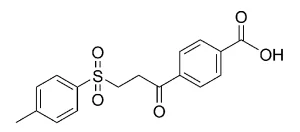Amino-dPEG®8-acid, product number QBD-10277, is an amino PEG acid. A primary amine and propionic acid terminate the ends of the polyethylene glycol (PEG) spacer. The single molecular weight PEG spacer is discrete (Ð = 1) and highly hydrophilic. Consequently, it increases the hydrodynamic volume and imparts water solubility to conjugates that incorporate it.
Both ends of the molecule are available for conjugation. Conjugation of only one end of the dPEG® spacer may modify the overall charge of the conjugate. Many different types of coupling reactions are effective for this purpose. However, care should be taken not to use single-step EDC coupling, as this will polymerize the dPEG® product.
Scientific publications report the use of Amino-dPEG®8-acid in modifying diverse compounds including antibodies, enzymes, carbon nanotubes, and SU-8 (an epoxy-based negative photoresist) layered atop a quartz surface. In each case, amino-dPEG®8-acid was shown to improve the performance of the conjugate compared to the unmodified material. The improved conjugate performance occurred through increased signal-to-noise ratio, reduced non-specific binding, or both.
| Unit Size | 100 mg, 1000 mg |
|---|---|
| Molecular Weight | 441.51; single compound |
| Chemical formula | C₁₉H₃₉NO₁₀ |
| CAS | 756526-04-2 |
| Purity | > 98% |
| Spacers | dPEG® Spacer is 28 atoms and 32.2 Å |
| Shipping | Ambient |
| Typical solubility properties (for additional information contact Customer Support) | DMAC or DMSO or water. |
| Storage and handling | -20°C; Always let come to room temperature before opening; be careful to limit exposure to moisture and restore under an inert atmosphere; stock solutions can be prepared with dry solvent and kept for several days (freeze when not in use). dPEG® pegylation compounds are generally hygroscopic and should be treated as such. This will be less noticeable with liquids, but the solids will become tacky and difficult to manipulate, if care is not taken to minimize air exposure. |
Greg T. Hermanson, Bioconjugate Techniques, 2nd Edition, Elsevier Inc., Burlington, MA 01803, April, 2008 (ISBN-13: 978-0-12-370501-3; ISBN-10: 0-12-370501-0). Specifically see pp. 726-729 in his Chapter 18 on discrete PEG compounds for pegylation applications.
Greg T. Hermanson, Bioconjugate Techniques, 3rd Edition, Elsevier, Waltham, MA 02451, 2013, ISBN 978-0-12-382239-0; See chapter 18, Discrete PEG Reagents, pp.787-821, for a full overview of the dPEG® products.
Spacer length effects on in vitro imaging and surface accessibility of fluorescent inhibitors of prostate specific membrane antigen. Tiancheng Liu, Jessie R. Nedrow-Byers, Mark R. Hopkins, Clifford E. Berkman. Bioorganic & Medicinal Chemistry Letters. 2011, 21 (23), pp 7013–7016 October 4, 2011. DOI:10.1016/j.bmcl.2011.09.115.
Short PEG-Linkers Improve the Performance of Targeted, Activatable Monoclonal Antibody-Indocyanine Green Optical Imaging Probes. Kohei Sano, Takahito Nakajima, Kiminori Miyazaki, Yuya Ohuchi, Takashi Ikegami, Peter L. Choyke and Hisataka Kobayashi. Bioconjugate Chem. 2013, 24 (5) pp 811–816. April 22, 2013. DOI: 10.1021/bc400050k.
Novel 3D LithographicallyPrepared Solid-Phase Surfaces Made from SU-8 for Next Generation Sequencing. Hong Wang, Makgorzata Witek, Daniel Park, Jianmin Huang,Francis Barany, Steven A. Soper. Miniaturized Systems for Chem and Life Sci. 2011, pp.73-75. October 6, 2011. DOI: www.rsc.org/images/LOC/2011/PDFs/Papers/026_0829.pdf
Drug loading, dispersion stability, and therapeutic efficacy in targeted drug delivery with carbon nanotubes. Elena Heister, Vera Neves, Constanze Lamprecht, S.Ravi P. Silva, Helen M. Coley, Johnjoe McFadden. Carbon. 2011, 50 (2) pp 622-632. August 31, 2011. DOI: 10.1016/j.carbon.2011.08.074.
Enzyme Catalytic Efficiency: A Function of Bio_nano Interface Reactions. Alan S Campbell, Chenbo Dong, Fanke Meng, Jeremy Hardinger, Gabriela C Perhinschi, Nianqiang Wu, and Cerasela Zoica Dinu. ACS Applied Materials and Interfaces. 2014, 6 pp 5393-5403. March 25, 2014. DOI: dx.doi.org/10.1021/am500773g.
Redirecting extracellular proteases to molecularly guide radiosensitizing drugs to tumors. Dina V. Hingorani, Jessica L. Crisp, Matthew K. Doan, Maria F. Camargo, Maryam A. Quraishi, Joseph Aguilera, Mara Gilardi, Larry A.Gross, Tao Jiang, Wei T. Li, Weg M.Ongkeko, Ezra E. W. Cohen, j. Silvio Gutkind, Stephen R. Adams, Sunil J .Advania. Biomaterials. 2020, Volume 248, July 2020, 120032. 04/11/2020. https://doi.org/10.1016/j.biomaterials.2020.120032
Applicable patents and legal notices are available at legal notices.



Stay in the Loop. Join Our Online Community
Products
Ordering
About Us
Application
Resources

©Vector Laboratories, Inc. 2025 All Rights Reserved.
To provide the best experiences, we use technologies like cookies to store and/or access device information. Consenting to these technologies will allow us to process data such as browsing behavior or unique IDs on this site. Not consenting or withdrawing consent, may adversely affect certain features and functions. Privacy Statement
How do I Request a Quote?
To request a quote for products: